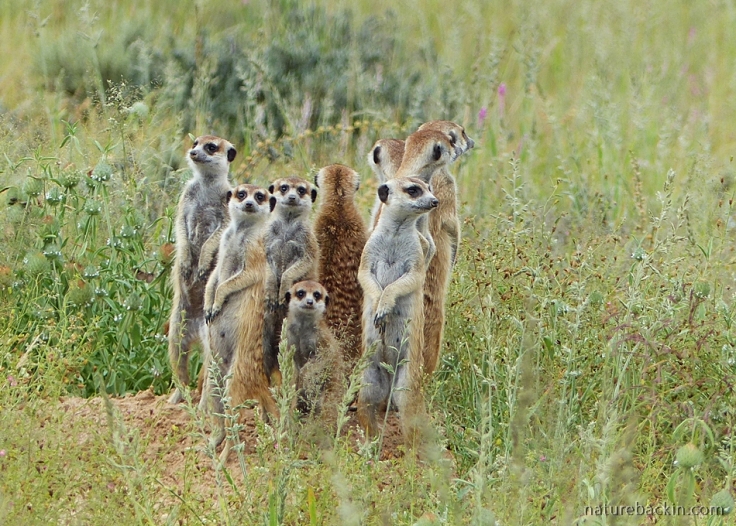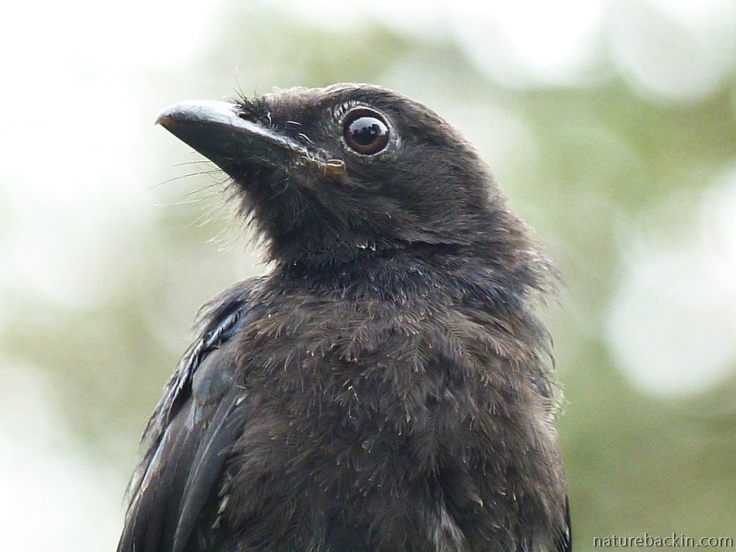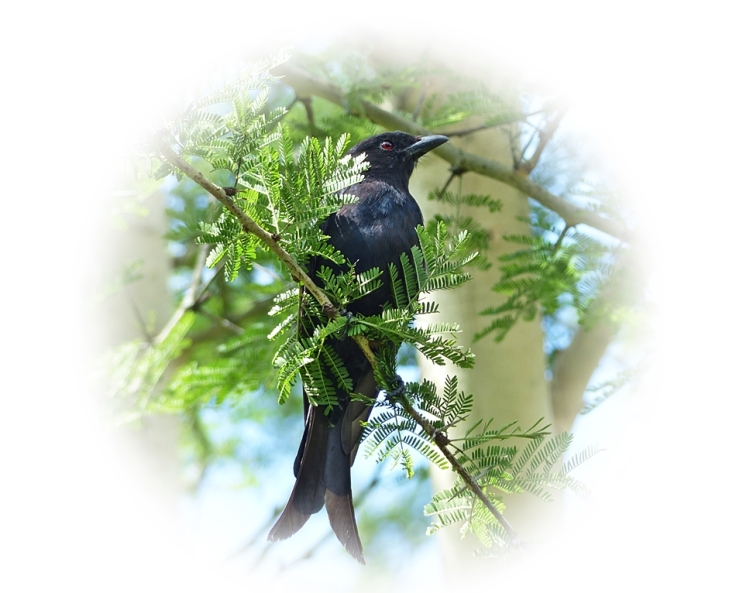Fork-tailed Drongos are active visitors to our garden. In the summer months they are at their most conspicuous, issuing their jumbled call while perching in trees, sallying forth to hawk insects.
In the 1985 edition of Roberts Birds of South Africa the calls of the Fork-tailed Drongo are rather delightfully described: “Song loud jumble of strident twanging, creaking and rasping sounds like unoiled wooden wagon wheels; imitates other birdcalls; call note single trumpetlike twank or twilling; vocal on moonlit nights”.
Drongos tend to be feisty birds and they can mob raptors and other predatory birds that are in their area. It is not unusual to see a drongo individual or pair flying above a raptor and “bombing” it from above in an effort to drive it away. They can also be aggressive near their nests, even driving away humans who venture too close.
The name “drongo” is taken from the Malagasy name for the Crested Drongo that is endemic to Madagascar, although there is a subspecies in the Comoro Islands. Globally, there are 29 species of drongo in total, and different species occur in Africa, Asia, Australia and some of the offshore islands.
In southern Africa there are two species of drongo, the Fork-tailed Drongo, which occurs over most of southern Africa (except in Namaqualand, much of the Karoo and Lesotho), and the smaller Square-tailed Drongo, which is confined to the south east and the east.

A Fork-tailed Drongo in our garden looking out for insects to hawk, showing off its deeply forked tail and its characteristic red eye
The Afrikaans name for this bird is Mikstertbyvanger, which means literally fork-tailed bee catcher, an aptly descriptive name, as these agile birds are skilled at hawking insects on the wing, and they have a particular fondness for bees. Fork-tailed Drongos are known for perching nearby to beehives to catch bees returning to the nest.
In addition to eating insects, caught both on the wing and on the ground, Fork-tailed Drongos are also known to eat insect larvae, to catch and eat small birds and lizards, to plunge to catch small fish and occasionally to eat flower nectar, and they have been observed stealing food items from small mammals such as mongooses and from other species of birds.

A Fork-tailed Drongo perching with freshly caught prey
The practice of stealing prey items that have been caught by other species is known as kleptoparasitism. One technique that Fork-tailed Drongos use when stealing food is to fly in aggressively and attack the target animal so as to rob it of its food.
The other strategy is most interesting – the Drongo uses deceit. Many species benefit from the alarm calls of other species in the vicinity, sometimes even seeking out the more aggressive and vocal species for “protection”. The Fork-tailed Drongo can use this response to its advantage by giving a “false” alarm call from its perch in order to frighten an animal with food to run for cover, dropping its food as it takes fright. The Drongo then flies down from its perch and retrieves the dropped food item.
Not only does the Drongo use its own alarm call to frighten a target animal off its food, but it also mimics the alarm calls of other species of birds to make its strategy even more effective. In an ongoing study in the Kalahari region, Fork-tailed Drongos have been seen targeting Pied Babblers and Suricates (Meerkats), when using deceptive alarm calls that cause a target animal to run for cover abandoning its food item in the process. Interestingly, juvenile Fork-tailed Drongos appear to learn this strategy from observing adult birds (Flower 2010).

In the Kalahari region, Suricates, also known as Meerkats, are a favoured target of Fork-tailed Drongos using deceptive alarm calls to frighten an animal into running for cover and dropping its food in the process, enabling the Drongo to steal its food. This group of Meerkats keeping an alert lookout for predators, I photographed in Mabuasehube in southern Botswana

A juvenile Fork-tailed Drongo watching from a perch in our garden. The pale grey edging on the feathers on its breast, and its brown (not red) eye reveal its juvenile status

Another juvenile Fork-tailed Drongo photographed in our garden. Although very young, this bird was hunting insects for itself. In addition to the speckled and rather dusky feathers and its brown eye, the rather fleshy gape flange reveals its young age
Fork-tailed Drongos are monogamous and solitary nesters. They make beautiful nests bound with spider web that are slung hammock-like across the horizontal fork of a tree branch. Chicks and fledglings are fed and cared for by both parents.

Fork-tailed Drongos are handsome birds. In our garden they quite often perch in the same trees as Southern Black Flycatchers, when hawking. They can be distinguished from the slightly smaller flycatchers by the red eye, forked tail and more robust bill with a slight hook

I was fascinated the first time I saw an elaborately scalloped tail of a Fork-tailed Drongo. This photograph was taken in Mabuasehube in southern Botswana, and was the first time I noticed such a tail, and at the time I wondered if it was a different subspecies. It turns out that the bird is in moult, with the new tail feathers growing through before the old feathers have been dropped, and so the tail appears to be double-forked

Sources: Flower T. 2010. Fork-tailed drongos use deceptive mimicked alarm calls to steal food. Proceedings. Biological sciences, 278(1711), 1548–1555. doi:10.1098/rspb.2010.1932. https://www.ncbi.nlm.nih.gov/pmc/articles/PMC3081750/; Maclean, Gordon Lindsay. 1985. Roberts Birds of Southern Africa (5th edition). Cape Town: Trustees of the John Voelcker Bird Book Fund; Roberts VII Multimedia PC Edition. 1997-2016 Southern African Birding. For details go to http://www.sabirding.co.za/roberts7/portal.html
Posted by Carol









February 11, 2021 at 7:15 am
It is the second time I have image searched a bird and found your blog! Great help, these images.
LikeLiked by 1 person
February 12, 2021 at 2:06 pm
Good to know! Thanks Liza.
LikeLike
April 25, 2019 at 2:25 am
How lucky you are to have these feisty and intelligent birds inhabit your garden, Carol! I can watch them all day long – it is like watching a soap opera, with their constant bickering and dramatic aerial displays to catch insects or drive away intruders.
LikeLiked by 1 person
April 25, 2019 at 5:06 am
A good description! After the recent heavy rains over several days, the drongos have emerged much more vocal than before.
LikeLiked by 1 person
April 25, 2019 at 5:17 am
These heavy, late rains we’re experiencing might be playing havoc with the biological clocks of many plants and animals…
LikeLiked by 1 person
April 25, 2019 at 5:28 am
I should think that is likely. We always need rain but not to the sadly tragic extremes of the past few days.
LikeLike
April 21, 2019 at 1:09 pm
Fascinating. Deceptive alarm calls is a new one for me. I will have to watch out to see if my local magpies (our ecosystem’s master kleptoparasite) does anything similar.
Fork-tailed drongos were one of the few birds that I was able to easily identify on my first visit to Africa and it is good to learn more about them. Thanks!
LikeLiked by 1 person
April 21, 2019 at 3:03 pm
It will be interesting to see if the magpies have any such strategy.
Nice to know you are familiar with Fork-tailed Drongos from your visits to Africa – they are quite hard to miss!
LikeLiked by 1 person
April 21, 2019 at 9:43 am
Fascinating post, they’re intriguing birds. I did not know that term ‘kleptoparasitism’ – devious creatures indeed!
LikeLiked by 1 person
April 21, 2019 at 2:57 pm
Thank you Liz. It is remarkable that they vary the alarm calls they use so as to keep their target animals wary!
LikeLike
April 20, 2019 at 6:40 am
Great set of photos as always and a great story to go with them. Seems like I saw something about their mimic call on one of David Attenborough’s TV shows. I forget which one, though I think the meerkats might have been involved. They must be a fun bird to observe on a regular basis.
LikeLiked by 1 person
April 20, 2019 at 8:09 pm
Thanks Graham. Yes they are nice to have around especially when they are vocalizing as to our ears it can sound quite cheerful. Of course in their own way they are really quite fierce!
LikeLiked by 1 person
April 20, 2019 at 3:08 am
What a fascinating bird. Perhaps a bit more like our flycatchers than corvids? But seemingly more advanced in stealing their meals. The image of the meerkats was precious. It would be a great treat to see them in real life, but not at all likely.
LikeLiked by 1 person
April 20, 2019 at 8:04 pm
Thanks Gunta. Yes it has the acrobatic hawking abilities of flycatchers, and in our garden drongos and flycatchers often hawk together from nearby perches. The drongo is a bit more robust about the bill and perhaps that gives it a slightly corvid appearance in addition to some of its behaviour. Meerkats can be very wary and so not always easy to observe, but if they allow it, they are fascinating to watch too, They seem to live on their nerves, even though the group members are incredibly supportive of each other.
LikeLiked by 1 person
April 20, 2019 at 2:20 am
Thank you for introducing me to the Fork-tailed Drongo. It sounds like the Coyote of birds, the Trickster in Native American lore. Your photos are exceptional, of Drongo and Meerkat also. I am happy to follow your blog for the uplifting content, beauty, and information herein. Thank you, Carol.
LikeLiked by 1 person
April 20, 2019 at 7:58 pm
That is an apt comparison – it is true the drongo is a Trickster. Thanks Cheryl, I try to keep an element of celebration in my posts, as celebrating the “ordinary” can help keep us more centred, especially when so much seems out of kilter.
LikeLike
April 19, 2019 at 9:41 am
I too, was thinking ‘corvid’; so many behaviours you have described here would apply to our crows, magpies etc. Although I’ve not heard of british corvids using that mimicking ploy – that’s remarkable. As are your photos, Carol 🙂
LikeLiked by 1 person
April 20, 2019 at 7:46 pm
Thanks Sandra. I think there is a lot to mimicry or copying in birds that is not really understood, so the studies investigating how drongos use mimicry are really interesting.
LikeLiked by 1 person
April 19, 2019 at 5:38 am
Yes, it does seem corvid in many ways, but clearly crows are not the only brainy birds around. What a fascinating introduction to a bird I’d never even heard of.
LikeLiked by 1 person
April 20, 2019 at 7:42 pm
Glad to introduce the drongo, and it is interesting that being bird brained is not as limited as one might think!
LikeLiked by 1 person
April 19, 2019 at 5:05 am
These are the best photographs of Fork-tailed Drongos I have ever seen – a wonderful post!
LikeLiked by 1 person
April 19, 2019 at 5:13 am
Gosh, thanks so much Anne! Drongos are another of my favourites. I suppose I should admit that I have so many favourites that the term loses its meaning 😊
LikeLiked by 1 person
April 19, 2019 at 5:15 am
They keep me entertained in our garden too!
LikeLiked by 1 person
April 19, 2019 at 2:18 am
I love Fork-tailed Drongos and have observed our resident pair rear a juvenile this year! Your photos are stunning, not easy to ‘catch’ them as they are so busy! Your blogs are an absolute delight, thank you Carol! xxxx
LikeLiked by 1 person
April 19, 2019 at 5:10 am
How interesting to see the parents rearing the youngster. You must be looking forward to perhaps seeing the same next season. Thanks Christeen. Yes they can be difficult to photograph as they are so alert and busy as you say, but I have found that if I wait near a perch they are hawking from, I might get lucky! The juveniles seem rather more confiding.
LikeLiked by 1 person
April 18, 2019 at 11:24 pm
Super photos of this striking bird, Carol. Is it a Corvid? Its cleverness made me wonder.
LikeLiked by 1 person
April 19, 2019 at 5:00 am
Thanks Eliza. It is a striking bird. I can see why you think it might be a Corvid, but it is not. Drongos form the single genus family Dicruridae, with the genus being Dicrurus. The drongos here are considerably smaller than crows and they are extremely agile and acrobatic fliers.
LikeLiked by 2 people